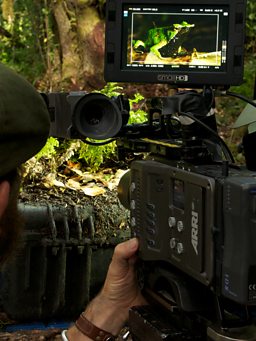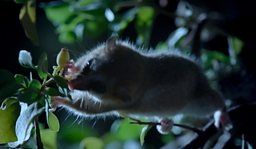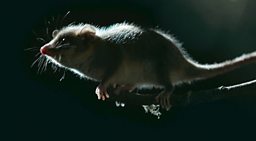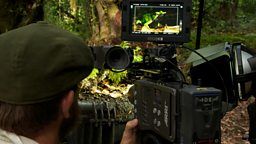Life in miniature
Tuppence Stone, series producer and director
Throughout the course of filming for the “Patagonia” series, the team wanted to not only film its iconic species, like pumas and Andean condors, but also to tell the story of its tiny residents…Patagonia’s unsung heroes.
the team reveal insights into the “macro world” that were truly extraordinary.Tuppence Stone
Filming small creatures is one of the hardest technical challenges for natural history camera operators, let alone filming complex behaviour in miniature.
Patagonia’s harsh climate and unrelenting winds meant that filming on a such a tiny scale was so difficult that some aspects of the animal’s behavior could only be successfully filmed under more controlled conditions. Through working with scientists on location in Patagonia, the team reveal insights into the “macro world” that were truly extraordinary.
A Frog in your throat… or several!
Darwin’s frogs, standing under 2.5cm tall, are unique to Patagonia, and have a very weird way of bringing up their young. After mating the dedicated father eats his own eggs. He keeps them in a special pouch in his throat, where they develop into tadpoles and then froglets, feeding on special juices he secretes. Then 4- 6 weeks later he regurgitates up to 20 miniature froglets.
While the frogs were taciturn subjects, we were able to build a small forest floor set within the rainforest and film wild male frogs that the scientists collected from the area aroundTuppence Stone
Working with Claudio Soto-Azat, scientists at La Reserva Biologica Huilo Huilo and Professor Juan Ortiz Zapata from the University of Concepcion, the Patagonia team tried to follow the story. While the frogs were taciturn subjects, we were able to build a small forest floor set within the rainforest and film wild male frogs that the scientists collected from the area around.
All the crew handling the frogs wore surgical gloves to prevent any chemicals passing from our hands onto their fragile skin.
Cameraman Toby Strong was able to capture dramatic footage on the froglets wriggling in dad’s throat, and the minute newly hatched froglets. Within a few hours the Darwin’s frogs were returned to the same places where they had been collected, and the vegetation put back on the forest floor.
More on Darwin's frogs:


On the trail of sticky poo…
Deep in Patagonia’s forests the team also wanted to tell the rather unusual story of one of it’s most elusive nocturnal residents, monitos del monte and their curious relationship with the Patagonian mistletoe, quintral.
As it turns out it takes just 20 minutes for the seeds to pass through a monito del monte, and they come out much as they went in, although now trailing a sticky stringTuppence Stone
Just a little larger than a mouse, monitos del monte or “monkeys of the mountain”, are survivors of an ancient lineage, not of monkeys but of marsupials, which are the ancestors of the kangaroo.
They are the sole seed dispersers of the quintral found in these forests, but in order for the seeds to successfully germinate, they must first pass through the gut of this plucky marsupial and, rather ingloriously, out the other end!
However the first challenge that the Patagonia team faced was that hardly anyone who lived in these forests has ever seen a monito in the fles To film this remarkable story, the team turned to renowned monito del monte scientist, Dr Guillermo Amico, to advise them on how to film this slightly inelegant behaviour!
To ensure the natural behaviour of the monito del monte, Guillermo and the team first arranged a feast of quintral fit for a king in a specially constructed 20 square metre enclosure. It was built in the forest where Guillermo works with the wild monitos and routinely traps them for his field studies. This allowed the team to set up the cameras close enough to the action without disturbing the natural behaviour of their little stars. With the stage set, Guillermo then carefully introduced a wild monito del monte to the enclosure.
After finding the quintral in the large enclosure the monito quickly tucked into the juicy berries – allowing the crew to film the seeds being eaten. Working with 4 monitos over the course of filming, meant none were being filmed for long. Each monito had a huge appetite, scuttling between clumps of berries, ignoring Guillermo and the team. It was then a waiting game for the inevitable!
As it turns out it takes just 20 minutes for the seeds to pass through a monito del monte, and they come out much as they went in, although now trailing a sticky string, acting as an adhesive, to help catch a branch. Each quintral seed must land on a host branch to start its new parasitic life; any seed that falls on the forest floor is as good as dead.
With Guillermo’s guidance and advice, the team we able to film this never-seen-before behaviour and the monitos del monte were released back into the wild at the site where Guillermo had caught them, with full stomachs.







